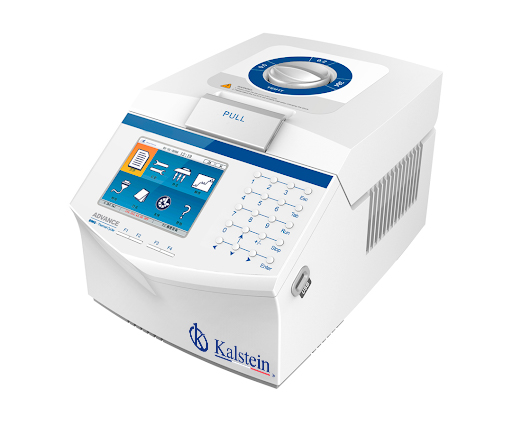PCR (polymerase chain reaction) is an artificially induced duplication of deliberately selected DNA sequences. In this case, duplicate sequences are again used as a template for additional duplications, so an exponentially increasing number of duplicates are obtained from an output sequence.
PCR can be used to provide genetic testing—for example, to solve crimes (genetic fingerprinting), to detect inherited diseases, viral infections, or to clarify family relationships (paternity testing, family trees). A disadvantage of this method is that it is not possible to replicate whole DNA strands, but only short sections (up to a maximum of 40 kilopair of bases (kpb), i.e., 40,000 base pairs). To do a PCR, the following are necessary:
- The DNA starting sequence to be examined (mold, Engl. Template).
- Two artificially created (constructed) primers as coupling points for the polymerase.
- Heat-resistant DNA polymerase (usually called Taq polymerase, a heat-resistant enzyme from the geyser-dwelling bacterium Thermus aquaticus).
- A solution containing, among other things, the necessary bases (deoxyribonucleoside triphosphates) as building blocks and providing a suitable working environment for the polymerase (buffer solution).
- A suitable device that generates the required temperatures for the individual stages (thermocycler).
In order for this chemical reaction to be carried out in reasonable times, enzymes must be used which, in addition to accelerating the speed of the reaction, must be stable under working conditions. In that sense, Taq polymerase, as you’ll see, was a breakthrough. On the other hand, other enzymes are also used for other purposes that increase the potency of genomic studies.
The importance of Taq polymerase in PCR
PCR had its problems in its beginnings. For example, thermally unstable DNA polymerase was first used for elongation and this new enzyme had to be added after each denaturation stage. In addition, three water baths with different temperatures were used. For a 30-cycle PCR, this meant adding the enzyme 30 times and converting it 90 times.
The methodological breakthrough was published in 1988, when the Taq polymerase was introduced. The thermostable enzyme survived denaturation and did not have to be added back after each cycle. In addition, specificity, detection sensitivity and yield were improved. Thanks to the Taq polymerase, PCR could be automated and the first thermocyclers came on the market in the late 1980s.
The Taq polymerase remains a popular enzyme. He isolated himself from the heat-loving aquatic thermophile, who lives near hot springs and geysers. The optimal enzyme extension temperature is between 75 ° and 80 ° C and has a half-life of 10 minutes at 97 ° C. If the enzyme is added only after the first stage of longer denaturation, the shelf life and activity are significantly prolonged. Reducing the denaturation temperature to 95 °C has the same effect.
In addition, they can compensate for a decrease in activity by increasing the time in the elongation phase. The Taq has an extension speed of 2 to 4.5 kilobases per minute and, of course, makes mistakes. It is said to produce an error on average every 4,200 bases, but many publications show that only every 10,000 to 125,000 bases incorporates an incorrect nucleotide.
What applications do restriction enzymes have in genomic studies?
Restriction enzymes are important tools in classical and modern molecular biology. Restriction enzymes, also restriction endonucleases, recognize specific DNA sequences and then cut DNA directly at the recognition site or at a defined distance. Restriction enzymes are traditionally used in molecular biology for cloning. Here, DNA digestion by enzymes is used to produce DNA-matched ends. These ends are then connected by DNA ligase.
The DNA to be cloned can be very different, from genomic DNA, to mRNA transcribed into cDNA, to a previously cloned gene that needs to move from one vector to another (subcloning). Restriction enzymes can also be used to create compatible endpoints of PCR products. In all cases, one or more restriction enzymes are used to digest DNA, allowing untargeted or directed insertion into the compatible plasmid.
Kalstein thermocyclers as a support in molecular biology research
All studies involving small DNA samples and their multiplication is required, we must resort to the methodology of PCR, which in turn is supported in a thermocycler. Kalstein, is a manufacturer of high-quality equipment in this field, and its thermocyclers, have as main characteristics its robustness for long work, cooling by Peltier technology and an interface that facilitates its handling. The purchase of these devices, their prices and quotes, can be consulted on the pages HERE and HERE.

